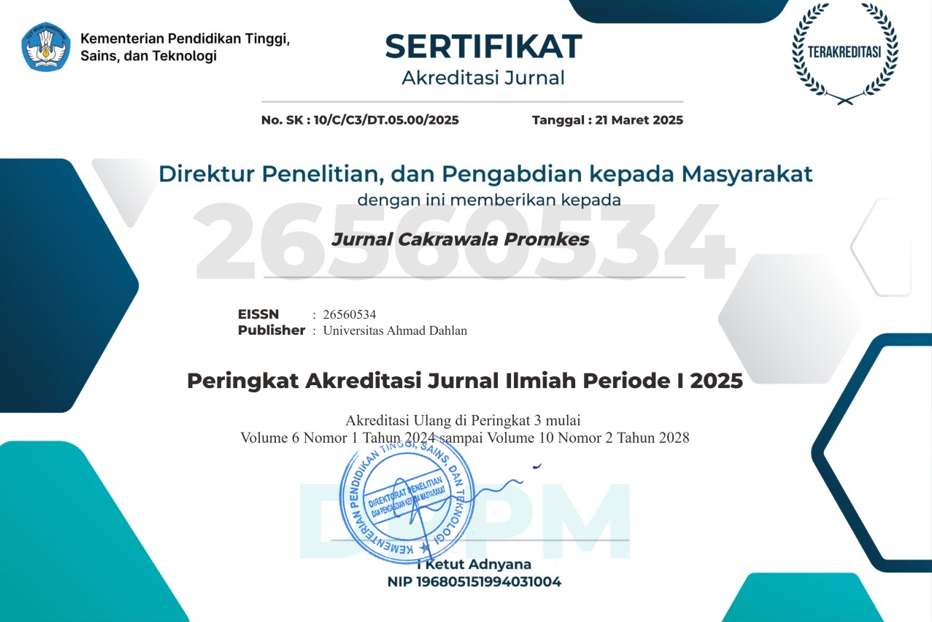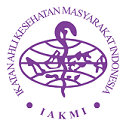Implementation of the seven steps of patient safety in primary healthcare
DOI:
https://doi.org/10.12928/jcp.v7i1.11239Keywords:
Patient safety, Seven steps of patient safety, Seven steps of patient safety in health careAbstract
Public health efforts and first-level individual health efforts organize primary health. One of the quality management indicators is patient safety, the safety steps are building awareness of the value of patient safety, leading and supporting staff, integrating risk reporting activities, developing reporting systems, involving and communicating with patients, learning and sharing experiences about patient safety, and preventing injuries through the implementation of patient safety systems. The study aimed to determine the implementation of the seven steps of patient safety at one of the primary healthcare facilities in Yogyakarta City. Qualitative research with phenomenological design. Determination of research subjects using a purposive sampling technique. The informants selected were the head of health care, the person in charge of individual health efforts, the patient safety team, the quality team, and the person in charge of pharmacy, laboratory, nurses, doctors, and midwives. Data collection techniques used include field observations, interviews, and document review. The results showed that one of the primary health care facilities in Yogyakarta City has implemented seven patient safety steps. The reporting culture has not been fully implemented, and not as much as expected. The patient safety assessment survey was used for the assessment process in patient safety, and there has never been a patient safety training program for primary health care officers. The seven patient safety steps have been implemented, but the incident reporting culture is still less than optimal.
References
Ministry of Health of the Republic of Indonesia. Pocket Book on Community Health Centers. Directorate of Basic Health Efforts, Directorate General of Health Efforts. 2014;1–54.
Ulumiyah NH. Improving the Quality of Health Services by Implementing Patient Safety Efforts in Community Health Centers. J Adm Kesehatan Indones. 2018;6:149–55. https://doi.org/10.20473/jaki.v6i2.2018.149-155
Maghfiroh L, Rochmah TN. Analysis of the Readiness of Demangan Health Center, Madiun City in Facing Accreditation. Media Kesehat Masy Indones. 2017;13:329. https://doi.org/10.30597/mkmi.v13i4.1665
Minister of Health Regulation. Regulation of The Minister of Health of The Republic of Indonesia Number on Standards And Instruments of Community Health Center Accreditation Second Edition, 2019 Version. Minister Of Health. RI. Jakarta; 2019.
Regulation of the Minister of Health of the Republic of Indonesia Number 11 of 2017 Concerning Patient Safety. Republic of Indonesia; 2017.
Kirana GR, Nurmalasari I. The Importance of Standardization of Patient Safety Procedures at Community Health Center X, Kediri Regency. Prev Indones J Public Heal. 2017;2:1–8 https://doi.org/10.17977/um044v2i2p104-111
Noer Octaviania, Hildab LN. Evaluation of the Implementation of the Seven Steps Towards Patient Safety at the Loa Kulu Health Center, Kutai Kartanegara Regency. J Kedokt Mulawarman. 2020;7:30–42. https://doi.org/10.30872/j.ked.mulawarman.v7i2.4255
Siregar RA. Nurse-patient relationship: Implementation of Patient Safety Standards. J Huk. 2019;2:239–316. https://doi.org/10.33541/tora.v2i1.1132
Rachmawati A, Wigawati P, Sriatmi A. Analysis of the Implementation of Seven Steps Towards Patient Safety in Hospitals. J Public Health. 2017;5:1–8.
DIY Health Office. Profile of the Yogyakarta City Health Office in 2019. Yogyakarta; 2020.
Delfia F, Adi K, Purnami CT. Evaluation of Health Information System with HOT-Fit Model: Literature Review. Media Publ Promosi Kesehatan Indonesia. 2022;5:633–9. https://doi.org/10.56338/mppki.v5i6.2344
Akib H. Policy Implementation: What, Why, How. J Public Adminstration. 2010;1:1–11. https://doi.org/10.26858/jiap.v1i1.289
Manongga A, Pangemanan S, Kairupan J. Implementation of the Family Hope Program in Overcoming Poverty in Pinokalan Village, Bitung City. J Jur Ilmu Pemerintahan. 2018;1:1–10.
Islami K, Arso SP, Lestantyo D. Analysis of the Implementation of the Patient Safety Program at the Mangkang Health Center, Semarang City. J Public Health FKM UNDIP. 2018;6:27–41. https://doi.org/10.34310/sjkb.v4i2.136
Tutiany, Lindawati, Paula Krisanti. Nursing Teaching Materials Patient Safety Management. 1st ed. Jakarta: PPSDM - Health Human Resources Development and Empowerment Agency; 2017.
Misnaniarti M, Destari PK. Important Aspects of Health Center Accreditation in Supporting the Implementation of National Health Insurance. J Health Service Researcher and Developer. 2018;2:10–6. https://doi.org/10.22435/jpppk.v2i1.35
Cooper J, Williams H, Hibbert P, Edwards A, Butt A, Wood F, et al. Classification of patient-safety incidents in primary care. Bull World Health Organs. 2018;96:498–505. https://doi.org/10.2471/BLT.17.199802
Rachmawati A, Wigati P, Sriatmi A. Analysis of the Implementation of the Seven Steps Towards Patient Safety at Sultan Agung Islamic Hospital Semarang. J Kesehat Masy Univ Diponegoro. 2017;5:1–7.
Ismainar H. Patient Safety in Hospitals. 1st ed. Yogyakarta: CV Budi Utama; 2015.
Setyani MD, Zuhrotunida Z, Syahridal S. Implementation of Patient Safety Targets in the Inpatient Room of Tangerang Regency Hospital. J JKFT. 2017;2:59. https://doi.org/10.31000/jkft.v2i2.63
Suparno. Implementation of Public Policy in Practice: Implementation of Food Security Policy in Rembang Regency. Sidoarjo: Dwiputra pustaka jaya; 2017.
Ministry of Health of the Republic of Indonesia. Draft Guidelines for Patient Safety and Risk Management in Primary Level Healthcare Facilities. Ministry of Health of the Republic of Indonesia. 2017.
Hadi I. Textbook of Patient Safety Management. Yogyakarta: CV Budi Utama; 2017.
Hakim L, Pudjirahardjo WJ. Optimization of Coordinating Process of Patient Safety Program in Hospital X Surabaya. J Adm Kesehatan Indones. 2014;2:198–208.
Downloads
Published
Issue
Section
License
Copyright (c) 2025 Sely Aprianda Syah Putri, Siti Kurnia Widi Hastututi, Nur Syarianingsih Syam, Linda Tri Maryuni

This work is licensed under a Creative Commons Attribution-ShareAlike 4.0 International License.
Authors who publish with JCP: Jurnal Cakrawala Promkes agree to the following terms:
- Authors retain copyright and grant the journal the right of first publication with the work simultaneously licensed under a Creative Commons Attribution License (CC BY-SA 4.0) that allows others to share the work with an acknowledgement of the work's authorship and initial publication in this journal.
- Authors are able to enter into separate, additional contractual arrangements for the non-exclusive distribution of the journal's published version of the work (e.g., post it to an institutional repository or publish it in a book), with an acknowledgement of its initial publication in this journal.
- Authors are permitted and encouraged to post their work online (e.g., in institutional repositories or on their website) prior to and during the submission process, as it can lead to productive exchanges, as well as earlier and greater citation of published work.

This work is licensed under a Creative Commons Attribution-ShareAlike 4.0 International License












